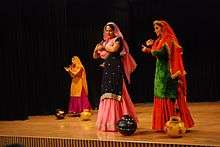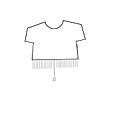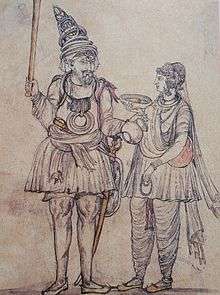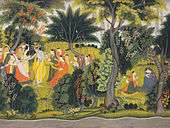Punjabi ghagra

The Punjabi ghagra (Punjabi: ਘੱਗਰਾ) is a four-piece outfit[1] known as tewar or 'ti-or' which was traditionally worn by Punjabi women throughout the Punjab region with the outfit comprising a head scarf (Phulkari), kurta or kurti,[2] ghagra and either a suthan (baggy trousers with a tight band at the ankles) or the Punjabi salwar.[3] In modern times, the ghagra is worn by women in parts of Haryana, rural parts of south West Punjab,[4] parts of Himachal Pradesh[5] and during performances of Giddha in East Punjab.[6]
History
The ghagra has its origin in the candataka, which had become a popular garment in the Gupta period.[7] The candataka was a men's half trousers[8] which eventually developed into the ghagra. The intermediate formation has been described as a shirt like dress for men and women from the neck to the thighs.[9][10] Candataka continued as a popular female dress in the seventh century.[11]
Outfit
The Punjabi ghagra is part of a four-piece ensemble: Phulkari, kurta/kurti, ghagra and suthan/salwar. The term tewar or ti-or suggests that the outfit was originally a three-piece ensemble[12] which would have comprised the head scarf, kurta/kurti/angi and the ghagra. However, when preparing clothes to give to the bride, the suthan/kurta or salwar kameez outfit is counted as bewar, comprising two articles, with the head scarf not being included. Randhawa (1960) suggests that the only difference between the ghagra ensemble and the Punjabi suit outfit is the addition over the ghagra in the ghagra outfit. Accordingly, even though the Punjabi ghagra is referred to as tewar/ti-or, it is a four-piece outfit and the Punjabi suit, a three-piece ensemble.
Phulkari
The head scarf generally consists of a large Phulkari embroidered using local designs.
Kurta/kurti/angi/choli
- Kurta/kurti
The upper garment is traditionally either a long kurta or a kurti which is a short coat.[13] The kurta is a remnant of the kurtaka which was short and had side slits. It was in use in the 11th century C.E.and provides a link to the kurta of the Punjab region.[14]
The kurti is a short cotton coat [15] or a mini anga (dress)[16] without side slits which is believed to have descended from the tunic of the Shunga period (2nd century B.C.).[17] The kurti during the early 1700s buttoned to the right[18] but later versions buttoned down the centre.
-

modern lehenga
-
Saraiki kurti
- Angi/Choli
The angi is the Punjabi name for the bodice which is a short sleeved vest which covers the breast but leaves the chest partly bear and the abdomen wholly exposed.[19] The angi can be worn with the kurti. The angi when worn on its own is called the choli, which covers the chest[20] and has a slip running further down in front. It has short sleeves and is tied behind.[21] The angi differs from the choli only in having no front slip.
One design of the choli is made of strips (or patches)[22] of many coloured silk or other material. The arms are generally bare and the stomach is left uncovered.[23] The choli is tied at the back with strings.[24] In the middle of the choli, a kubba is dangled which is a hollow knobby ornament with a pendant fixed onto the centre of the choli. The item used is the tukma which is a silver pendant fixed on to the ends of the choli.[25] The choli was a popular alternative to the kurta in the 20th century,[26][27][28][29] and was in use in the Punjab region since at least the 16th century.[30] It is still popular in Multan where the Multani choli is embroidered in different colours or hand printed, tied at the front or the back.[31] Modern versions of the choli are also worn.
-

Model in White Lehenga and choli
-

Punjabi Choli with jewellery
Ghagra
The ghagra is a piece of clothing which can vary from 9 to 25 yards [32] The picture on the right shows the styles worn by Saraiki speaking women in west Punjab. The ghagra is traditionally worn by women of all communities.[33]
The materials used for making ghagras can either be malmal or muslin. The edge is finished with either a row of pin tucks, embroidery, gota or by putting a border of daryai (stiffened cloth).The malmal ghagra is traditionally starched (maandi) along with mica or vark which shines in the sun. Vark is similar to thin layers of stiff paper which is crushed and added to maandi (starch).[32] Other materials used for ghagras are hari-shael, latha,[34] saatan (satin), embroidered phulkari, parachute cloth etc. Parachute cloth is a silky material and perhaps similar to the textile used to make parachutes. For formal occasions the ghagra is made of expensive material with some embellishments like gota or embroidery.
Suthan/Salwar
It is traditional to wear either a suthan or a salwar under the ghagra. In Lahore[35] and East Punjab, the ghagra however was only worn when going outdoors[36] or in some areas, when going to another village in which case the kurta/kurti would be replaced by a choli.[37][38] Women were expected to continue to wear the ghagra over the suthan[39] or the salwar until old age or until at least the eldest child got married.[34] It was also customary to wear the ghagra on festive occasions and when attending funerals. It is still used by elderly ladies and is worn on special occasions.[40] Older Punjabi women living in the United Kingdom recall wearing the ghagra over the salwar.[41]
Usage
The Punjabi ghagra was envogue in West Punjab[42] and East Punjab on a wide scale during the 1960s.[43] However, during this time, the Punjabi ghagra began to decrease in popularity and the Punjabi Salwar Suit became to be worn on its own,[32] albeit in some villages in East Punjab the Punjabi ghagra is still worn at funerals.[44] Further, the ghagra is still worn in parts of Haryana,[45] parts of Himachal Pradesh and West Punjab.
Lehnga
A variation of the ghagra is the lehenga which is traditionally made of finer material than the ghagra as noted in 1878.[46] The lehenga was traditionally popular in urban areas and it is still customary for Punjabi brides to wear the lehngha.
Ghagri
A shorter version of the ghagra is the ghagri which does not drop to the ankles. This version is traditionally worn in Haryana and Himachal Pradesh but began to lose popularity during the 1960s.[43] In the plains of Punjab, the ghagri was an indoor item.[47]
Luanchari
Luanchari is a full-dress made of two parts stitched together: the upper part is the choli and the lower is the lehanga.[48] It is traditional garment worn by Gaddis of Himachal Pradesh.[48]
Photo gallery
-

Phulkari from Patiala
-

Sketch of a woman (right) wearing a suthan
-
Punjabi kurta and lehenga
-

Bridal lehenga with Gota Embroidery
-

Pahari painting depicting women in Luanchari. ca.1760
-

Himachal women in Luanchari
-

Geeta Basra lehenga choli
-
_seated_on_a_cushion..jpg)
Rani Jindan (1817-1863) in a ghagra and kurta
See also
References
- ↑ Punjab District Gazetteers: Ibbetson series, 1883-1884
- ↑ Biswas, Arabinda (1985) Indian Costumes
- ↑ http://revenueharyana.gov.in/html/gazeteers/hissar%201915.pdf
- ↑ Chaudhry, Nazir Ahmad (2002) Multan Glimpses: With an Account of Siege and Surrender
- ↑ Mehta, Parkash and Kuma, Anjala (1990) Page 19 Poverty and Farm Size in India: A Case Study
- ↑ Nrityabhakti.com
- ↑ Subbarayappa, B. V. (1985) Indo-Soviet Seminar on Scientific and Technological Exchanges Between India and Soviet Central Asia in Medieval Period, Bombay, November 7–12, 1981: Proceedings
- ↑ Bose, Mainak Kumar (1988) Late classical India
- ↑ Gupta, Dharmendra Kumar (1972) Society and Culture in the Time of Daṇḍin
- ↑ Chandra, Moti (1973) Costumes, Textiles, Cosmetics & Coiffure in Ancient and Mediaeval Indi
- ↑ Uma Prasad Thapliyal (1978) Foreign elements in ancient Indian society, 2nd century BC to 7th century AD
- ↑ Ghurye, Govind Sadashiv (1966) Indian Costume
- ↑ Gazetteer of the Hoshiarpur District: 1883-84. Sang-e-Meel Publications, 2001.
- ↑ Sharma, Brij Narain (1966)
- ↑ Punjab District Gazetteers: Rawalpindi District (v. 28A) (1909)
- ↑ Compiled and published under the authority of the Punjab government, (1939)Punjab District and State Gazetteers: Part A].
- ↑ Panjab University Research Bulletin: Arts, Volume 13, Issue 1 - Volume 14, Issue (1982)
- ↑ Nijjar, Bakhshish Singh (1972) Panjab Under the Later Mughals, 1707-1759
- ↑ Punjab gazetteers, 1883, bound in 10 vols., without title-leaves
- ↑ Gazetteer of the Jalandhar District 1884
- ↑ C. A. Roe and W. E. Purser (1878) Report on the revised land revenue settlement of the Montgomery District in the Moolitan Division of the Punjab
- ↑ Gazetteer of the Muzaffargarh District 1884
- ↑ Baden Henry Baden-Powel (1872) Hand-book of the Manufactures & Arts of the Punjab: With a Combined Glossary & Index of Vernacular Trades & Technical Terms ... Forming Vol. Ii to the "Hand-book of the Economic Products of the Punjab" Prepared Under the Orders of Government
- ↑ Dr SIngh, Daljit (2004) Punjab Socio-Economic Condition (1501-1700 A.D.)
- ↑ Punjab District Gazetteers: Mianwali district (v. 30A) 1915
- ↑ Punjab District Gazetteers 1931
- ↑ Punjab District Gazetteers: Jhang district, 1929
- ↑ Rajasthan [district Gazetteers].: Ganganagar 1972
- ↑ Saini, B.S. (1975) The Social & Economic History of the Punjab, 1901-1939, Including Haryana & Himachal Pradesh
- ↑ Karine Schomer, W. H. McLeod (1987) The Sants: Studies in a Devotional Tradition of India
- ↑ United States Treaties and Other International Agreements 1988
- 1 2 3 Eh Mera Punjab
- ↑ Punjab District Gazetteers Volume VII Part A Multan District 1923-1924
- 1 2 Punjabi Sabhiachaar barey by Jit Singh Joshi Waris Shah Foundation
- ↑ Sir Walker, George Casson (2006) Gazetteer of the Lahore District, 1893-94
- ↑ Sidhu Brard, Gurnam Singh (2007) East of Indus: My Memories of Old Punjab
- ↑ Final report on the revision of settlement, 1878-83, of the Ludhiána district in the Panjáb ..
- ↑ Sir George Casson Walker (2006) Gazetteer of the Lahore District, 1893-94
- ↑ Sir Wilson, James (1884) Final Report on the Revision of Settlement of the Sirsá District in the Punjáb
- ↑ Punjab District Gazetteers: Rupnagar 1987
- ↑ Rait, S.K. (2005) Sikh Women in England: Their Religious and Cultural Beliefs and Social Practices
- ↑ Walter L. Slocum, Jamila Akhtar, Abrar Fatima Sahi (1960) Village life in Lahore District: a study of selected sociological aspects
- 1 2 Mohinder Singh Randhawa. (1960) Punjab: Itihas, Kala, Sahit, te Sabiachar aad.Bhasha Vibhag, Punjab, Patiala.
- ↑ Alop Ho Reha Punjabi Virsa Harkesh Singh Kehal
- ↑ Sr.Bimcy, Sr.Sisily, Charlotte (2005) Spotlight Social Studies 3
- ↑ C. A. Roe and W. E. Purser. Report on the revised land revenue settlement of the Montgomery District in the Mooltan Division of the Punjab (1878)
- ↑ Sidhu, Gurnam Singh (2007) Brard East of Indus: My Memories of Old Punjab
- 1 2 Textiles, Costumes, and Ornaments of the Western Himalaya - Omacanda Hāṇḍā - Google Books. Books.google.co.in. Retrieved 2013-10-25.
